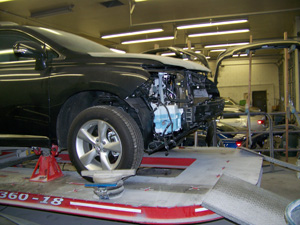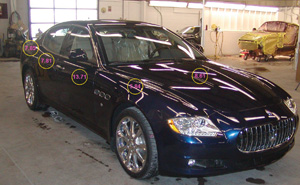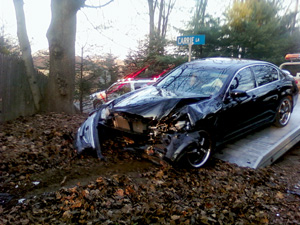It’s been over 15 years since Jim Lynas rocked the world of collision repair by introducing the Wreck Check system, a computer application that assesses the loss of value a vehicle sustains due to collision damage, poor quality repairs or any combination of the two. For the vast majority of repairers, this was their first exposure to diminished value (DV). According to one industry source, Lynas has done a vanishing act and literally disappeared to parts unknown, but his Wreck Check system has left an indelible mark on the collision repair industry.
The Total Solution?
When Lynas first introduced his system, he marketed it as the solution to virtually every problem the industry had, from short sheets to fraudulent repairs. For example, his program assessed what was termed “insurance-related DV” – defects in the repair work based on the omission of critical procedures from the insurer estimate. This concept, however, ran into a wall since a repair facility is ultimately responsible (read: liable) for the final product of the repair work. If a shop can’t cost-shift the funds allocated in the estimate to cover procedures that are necessary to complete a quality repair as judged by the customer, it’s free to decline the repair or reject the settlement offer.
Wreck Check did, however, introduce one useful tool: the Notice of Deficiency (NOD). The NOD put an insurer on notice for the consequences of a shop actually omitting a named procedure from a repair, such as covering a car for overspray damage. The NOD was supposed to shift the liability from the shop to the insurer. In fact, Lynas encouraged shops to omit procedures from a repair and let the chips fall where they may. So his devoted followers delivered cars to customers with urethane overspray all over them and tried to blame insurers, which turned out to be a disastrous strategy that led to most of those shops being shut down.
Inherent DV
Most people understand inherent DV to be the perception that a collision-damaged vehicle is worth less than one that never sustained damage. This is generally regarded as a reasonable assumption given consumer attitudes, as well as the various state laws regarding disclosure of damage history in the sale of new and used vehicles. And with the advent of consumer-accessible databases such as CarFax and Auto-Check, the stigma caused by collision damage has grown in terms of its effect on used car prices and values.
There are some people, however, who deny that inherent DV exists: insurers, for instance, and at least one mainstream collision repair association. Insurers, of course, deny it because they don’t want to be on the hook for it. As for the collision repair association, it’s hesitant to acknowledge that its members’ customers’ cars are worth substantially less once they leave their shops.
The insurance industry continues to ignore the increasing number of DV claims. I recently did a DV appraisal for a woman whose 2004 Nissan Murano sustained more than $13,000 in damage. When she asked about the loss in value resulting from the damage caused by the GEICO insured, the adjuster told her that, in actuality, her car was more valuable because new 2009 parts were installed on her car during the repair.
A Growing Industry
Web-based companies that say they can assess DV losses remotely have been popping up all over the place like mushrooms after a summer rain. While the business of collision repair was shrinking even well before the general economic malaise took hold early last year, the enterprise of selling DV assessments has been growing enormously over the last 10 years judging by the increasing number of purveyors marketing to consumers.
Richard Hixenbaugh, owner of CollisionClaims.com, which calls itself “The Diminished Value Expert,” said that not all companies looking to cash in on the DV assessment craze are good.
“The ones that cause me the greatest concern are the ones that claim to work on a percentage basis,” said Hixenbaugh. “Many of these companies end up settling claims for no more than the owner could have gotten simply by asking, and then the so-called DV company takes 30 percent. In some cases, it even takes additional fees for appraisals. This just ends up leaving a bad taste in the mouth of the consumer.”
A company working on a percentage-based fee is enriched by the settlement, which compromises one’s disinterested status in developing the figures. Since statements made by a DV appraiser must hold up in a court of law, as every claim is subject to litigation, one can only imagine the consequences.
Consumer Interest
Consumers are also showing an increased interest in DV, due in no small measure to hearing the term all over the news due to vehicle recalls. Some automakers are being sued by lawyers who claim that their clients had economic losses because of the diminished values of their vehicles. The growth in consumer-accessible databases such as CarFax and AutoCheck that are chock-full of information related to collision damage has also put a magnifying glass on used vehicles and increased DV claims.
The fact that we’re in the information age has not escaped the automotive industry, as more information is stored, shared and crunched than ever before. Black box technology has enabled the recording of data for five seconds before a crash and several seconds after, and DV appraisers can now access that data from the data port using an OBD II generic scan tool. For example, an airbag deployment will throw a permanent code into the vehicle’s onboard computer – but that information is currently only accessible with a proprietary system found at a new car dealer.
Legal Definition
Barry Zalma, a sole practitioner of law with a specialty in insurance matters, says about DV:
“The measure of damages should be that amount necessary to compensate the injured party for the damages proximately caused by the conduct of the person causing injury. That measure is often difficult to determine and is seldom able to fit into a hard rule of thumb. Rather, every possible means of providing complete indemnity is required when dealing with tort damages, contract damages and the proper amount of payment required by a contract of insurance. The courts of the various states and federal jurisdictions do not apply the same rule. To properly understand the issue and to apply the proper remedy requires an understanding of how each state applies what it believes to be the proper measure of damages for tort, contract breaches and insurance claims situations.
“Third-party claims (claims against an insured person for damages done to the property of some third person) for ‘diminution of value,’ on the other hand, have generally been found by the courts to be covered by auto insurance since the measure of damage in tort claims (which the insurer promises to pay) is the difference in value of the property before and after the loss.”
Insurers, for the most part, who in most cases are footing the bill to compensate claimants for DV losses, disagree with that definition.
“We do not believe that it is automatic or inherent that an auto’s value diminishes after an accident if the proper repairs by a skilled professional are made as they should be,” says State Farm spokesperson Gary Stephenson.
Courts in Texas, Maine, South Carolina and Delaware have agreed with State Farm, ruling against the idea of DV on a first-party basis in past cases. However, judges in several states, including Georgia and Kansas, have ruled that insurers must compensate policyholders for any real loss of value from an accident, regardless of whose fault the accident was.
Since value is central to the concept of a loss, the way one determines pre-loss value when assessing losses is critical. Richard Diklich, a noted expert in auto valuations whose opinions are used by attorneys nationwide, said, “In the used car world, whether it’s a dealer, an insurance company or an individual, the value is set by comparison of your vehicle with others of similar provenance. The usual basics, such as year, make, model, miles, equipment/features and color will establish the value in a guidebook. Use of a guide is important as it recognizes the information that’s available in the industry. I call [those guides] recognized tools or treatises in the industry.”
An Expanding Range
DV has expanded the range of auto valuations significantly to reflect various conditions of a car, from “original” (the most preferred state) to “rebuilt from a total loss,” with all states of repairs in between.
“There at least has been a greater recognition that there are many reasons that someone would pay less for a vehicle,” said CollisionClaims.com’s Richard Hixenbaugh. “Much of this actually started when dealers started offering ‘certified pre-owned vehicles.’ They created a condition class that was supposed to be better than the otherwise clean vehicle. Then, with the advent of CarFax and AutoCheck, consumers were educated to the fact that there were potentially other factors that should be considered in the purchase of a vehicle that could actually reduce a vehicle’s desirability, marketability and value. These new categories, however, have not yet been formally named or categorized by dealers, auctions or value guide books.”
Rocco Avellini, one of the early Wreck Check operators and present holder of the Wreck Check brand, operates Wreck Check Car Scan Centers (WCCSC), a post-repair inspection center based in Las Vegas and Southern California. He uses an image-based measuring system to assess the accuracy of repairs for consumers. Avellini had thought that the idea might catch fire.
“The idea of starting a post-repair inspection (PRI) industry occurred to me while [Lynas] was testing the CadScan equipment (electronic measuring device),” Avellini said. “Having a Wreck Check Car Scan Center similar to a Jiffy Lube with two to three bays where consumers could bring their vehicles for post-repair inspections seemed like a natural progression.”
Avellini is selling the software to new licensees for $2,000 and $500 to established Wreck Check licensees, with a $25 fee for each DV generated. He claims he has the “real” DV numbers thanks to hundreds of visits to auctions and thousands of hours spent with used car dealers and body shops.
What the “real” DV numbers are is a tricky thing. While establishing “comps” or comparable cars is the only sure-fire way to appraise something for its value, be it personal or real property, no one can be absolutely certain as to what a formerly damaged vehicle will sell for given full disclosure to a buyer and a willing seller. The only definitive measure of the loss is to sell the car with full disclosure of the damage history, at which point one deducts the net proceeds of the sale from an agreed upon pre-loss value to arrive at a hard figure.
The used car market has definitely affected DV, says Avellini.
“I’ve found that the honest dealers are shipping vehicles with prior collision damage to auctions because they don’t want to deal with the liability,” he said. “Of course, you still have the local dealers and manufacturers’ dealers that believe it’s acceptable to sell hacked vehicles. I do lots of dealer fraud cases, and I find that these types of dealers don’t care about disclosure because they feel they can either discourage the consumer from filing a lawsuit, make minimal repairs to get the vehicles past the warranty period or sell the car ‘as is’ and tell consumers they have no recourse.”
Avellini says his new Wreck Check software takes into consideration factors like the impact that damage has on warranty coverage, which the car-buying public tends to value. Drivetrain coverage is the most valued portion of the warranty coverage, given the cost of replacing an engine, transmission or differential component. However, these items aren’t usually damaged in collisions. On the other hand, if a door is replaced by a non-OEM service provider (the majority of body shops fit this category), then it’s possible that a warranty claim on a defective window regulator may bounce.
When asked if he could see a quantifiable increase in repair quality as a result of the PRI business, Avellini said, “I personally am not seeing the quality improving. Years back, I believe the PRI industry helped the quality-minded shops, but it seems to be getting back to business as usual. In this economy, insurers are squeezing every penny out of the job and, of course, are forcing shops to cut corners.”
The PRI practice has introduced peer review to the body shop business, a notion which has been effective in many other professions and businesses. As it spreads, the noble ideas that Lynas was spreading while promoting his system may cause some changes in collision repair facilities’ business practices.
Concept Taking Hold
Whether or not you believe a customer’s car is worth less than it was prior to being damaged, the concept of DV has taken hold in the public and will continue to do so as time progresses. If you think of DV this way, perhaps the concept will make more sense: Upon impact, a vehicle loses a tremendous portion of its value. Collision repairs restore the majority of value lost in an accident. That relatively small portion missing at the completion of repairs, however, is what is known as DV.
Charlie Barone has been working in and around the body shop business for the past 35 years, having owned and managed several collision repair shops. He’s an ASE Master Certified technician and a licensed damage appraiser, and has been writing technical, management and opinion pieces since 1993. Barone can be reached via e-mail at [email protected]. 















